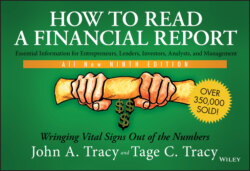Читать книгу How to Read a Financial Report - John A. Tracy - Страница 12
2 TWO BEDROCK FINANCIAL STATEMENTS Need for Financial Information
ОглавлениеBusiness managers, lenders, and investors need to know the financial condition of a business. They need a report that summarizes the business entity’s assets and liabilities, as well as the ownership residual of its assets in excess of liabilities. And they need to know the profit (or loss) performance of the business. They need information that summarizes sales revenue and expenses for the most recent period and the resulting profit or loss.
The means of communicating such financial information are financial statements. Accountants prepare the financial statements. They are the financial scorekeepers of the entity. Financial statements are sent regularly by a business to its managers, lenders, and investors—and, anyone else with a legitimate interest in the business for that matter. Financial condition is communicated in an accounting report called the balance sheet. Profit-motivated activities are presented in an accounting report called the income statement.
Alternative titles for the balance sheet include the statement of financial condition or the statement of financial position. An income statement may be titled as a statement of operations or an earnings statement. We stick with the names balance sheet and income statement to be consistent throughout the book. Informally, financial statements are called simply financials.
In almost all cases financial statements are supplemented with additional information, which is presented in footnotes and supporting schedules. One very common supporting schedule is the statement of changes in stockholders’ (owners’) equity. The broader term financial report refers to all this, plus any additional commentary from management, narrative explanations, graphics, and promotional content that accompany the financial statements, footnotes, and supporting schedules. Distribution of the financial reports of a private business may be restricted to its top-level managers, its shareholders, and major creditors. Federal laws require publicly owned businesses to make their financial reports publicly available.
The income statement and balance sheet for the company example introduced in Chapter 1 are presented here in Exhibits 2.1 and 2.2, respectively. The format and content of these two financial statements apply to manufacturers, wholesalers, and retailers—businesses that make or buy products that are sold to their customers. Although the financial statements of service businesses that don’t sell products differ somewhat, Exhibits 2.1 and 2.2 illustrate the basic framework and content of income statements and balance sheets for all businesses.
EXHIBIT 2.1 INCOME STATEMENT FOR YEAR
| Dollar Amounts in Thousands | |
| Sales Revenue | $ 52,000) |
| Cost of Goods Sold Expense | (33,800) |
| Gross Margin | $ 18,200) |
| Selling, General, and Administrative Expenses | (12,480) |
| Depreciation Expense | (785) |
| Earnings Before Interest and Income Tax | $ 4,935) |
| Interest Expense | (545) |
| Earnings Before Income Tax | $ 4,390) |
| Income Tax Expense | (1,748) |
| Net Income | $ 2,642) |
EXHIBIT 2.2 YEAR-END BALANCE SHEETS
| Dollar Amounts in Thousands | |||
| Last Year-End) | This Year-End) | Change) | |
| Cash) | $ 3,735) | $ 3,265) | $0(470) |
| Accounts Receivable) | 4,680) | 5,000) | 320) |
| Inventory) | 7,515) | 8,450) | 935) |
| Prepaid Expenses) | 685) | 960) | 275) |
| Current Assets) | $ 16,615) | $ 17,675) | |
| Property, Plant, and Equipment) | $ 13,450) | $ 16,500) | 3,050) |
| Accumulated Depreciation) | (3,465)) | (4,250)) | (785) |
| Cost Less Depreciation) | $ 9,985) | $ 12,250) | |
| Intangible Assets) | $ 5,000) | $ 5,575) | 575) |
| Long-Term Operating Assets) | $ 14,985) | $ 17,825) | |
| Total Assets) | $ 31,600) | $ 35,500) | $ 3,900) |
| Accounts Payable) | $ 2,675) | $ 3,320) | $ 645) |
| Accrued Expenses Payable) | 1,035) | 1,515) | 480) |
| Income Tax Payable) | 82) | 165) | 83) |
| Short-Term Notes Payable) | 3,000) | 3,125) | 125) |
| Current Liabilities) | $ 6,792) | $ 8,125) | |
| Long-Term Notes Payable) | $ 3,750) | $ 4,250) | 500) |
| Capital Stock—793,000 shares and 800,000 shares respectively) | $ 7,950) | $ 8,125) | 175) |
| Retained Earnings) | 13,108) | 15,000) | 1,892) |
| Stockholders’ Equity) | $ 21,058) | $ 23,125) | |
| Total Liabilities and Stockholders’ Equity) | $ 31,600) | $ 35,500) | $ 3,900) |
